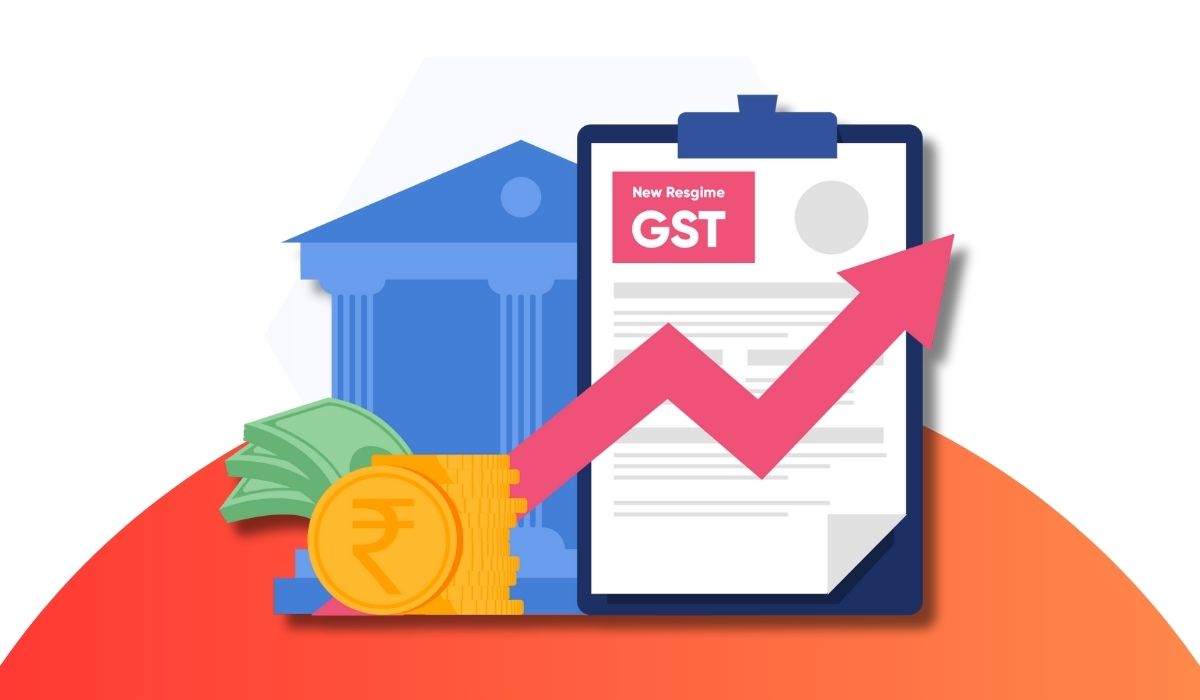The Goods and Services Tax, or GST, was introduced in India in 2017 to streamline the tax system and reshape how tax is charged on goods and services. Since then, it has affected various industries in the country, including the financial services GST. The impact of GST on financial services is great. It affects transactions, processing fees, and service charges on financial products.
Understanding the role and implications of the GST for financial services has become essential, as it affects both businesses and individuals during financial services transactions. This blog provides an overview of the GST and its impacts on financial services, giving insight into its impact on various financial sectors.
Financial Services: An Overview
Financial services enable economic growth and facilitate financial transactions in this modern world. Financial services comprise a broad range of organisations that manage finances and provide financial security and investment opportunities. These organisations promote the growth and success of individuals and businesses by assessing them to organise the financial resources effectively. The major categories in which financial services are categories are:
Types of financial services:
Below is the complete overview of financial services which are categorised into these major categories:
- Baking services: These include a variety of banking operations like saving and current accounts, credit facilities, payment facilities or transfer of funds and other services provided by banking institutes.
- Investment services: This field covers all the services related to the investment like management of stocks in the market, mutual funds and exchange-traded funds, portfolio management and wealth advisory.
- Insurance services: This category of financial services provides risk management solutions such as life insurance, health insurance and other general insurance that protects the individual from potential risk by planning beforehand.
- Accounting services: Accounting and bookkeeping services include financial reporting, tax filing, auditing financial reports and financial analysis.
Understanding these categories of financial services is necessary for individuals and businesses so that they can make decisions and manage their finances effectively. This overview showcases financial services’ broad application in the economy and how they provide financial stability.
GST and Financial Services
GST is a unified tax that replaces many indirect taxes in India. The introduction of the Goods and Services Tax (GST) in India had a great impact on the broad financial services sector, which plays a vital role in the country’s economy. Under GST implementation, these financial services are now subject to this unified tax rate. This method has organised the taxation of all financial services, such as banking, insurance, investment, and accounting, which also ensures transparency.
GST rates for Financial Services:
Classified under Services Accounting Code (SAC), 9971, a fixed rate of 18% is applied to various financial services like:
- Service charges for credit cards
- Investment management fees
- Insurance premiums
- Loan processing fees
Purpose of GST for Financial Services:
The major purpose of the GST system is to make the tax system easier and more transparent by unifying the tax application and replacing the traditional scattered tax framework. By introducing a standard tax rate across all financial services, GST removes the challenges of multiple levies like service tax and VAT. After the application of GST, a clear breakdown of taxes is provided which ensures transparency and eliminates any hidden or unexpected cost for the customer. GST also ensures economic integration by unifying the taxation system, enhancing a more effective and reliable financial ecosystem.
Types of Financial Services Affected by GST
The introduction of AI has led to a total change in the way tax treatment affects financial services. The table below shows the type of GST financial services, GST rates applicable to them and the notable changes regarding these services as compared to the pre-GST regime.
| Types of Financial Services | GST Rates | Notable Changes (Pre- vs. Post-GST Implementation) |
| Banking Services | 18% | Banking services like loan process, ATM services, and account maintenance charges are now subjected to 18% GST, which was earlier only 15% service tax. |
| Insurance Services | 18% | Tax on insurance services like life insurance, health insurance and other general insurance increased from 15% to 18%. Certain life insurance services are exempted from tax implications. |
| Investment Services | 18% | Tax implication on investment services like mutual fund management, stock brokerage, and portfolio advisory also increased from 15% service tax to 18% GST. |
| Accounting and Taxation services | 18% | Accounting services like bookkeeping, auditing, tax filing and compliance services saw an increase from 15% to 18%. |
This classification of affected financial services has shown how GST implications have straightened out tax structures. Although a slight increase in the cost can be seen in a few areas, it ensures transparency and consistency in tax implications.
Impact of GST on Financial Services
GST has made a significant impact on the financial service sector, affecting businesses and customers. GST is a uniform tax structure that has streamlined the taxation process but with many advantages, it has brought some drawbacks. Here we discuss the impacts of GST, GST advantages and GST drawbacks with examples from the financial industry.
Positive Impacts:
- Simplification of Tax Structure: Multiple indirect taxes like service tax and VAT are replaced by GST, a single unified tax.
Example: Before GST, banks had to comply with varying state taxes; now, a unified GST ensures streamlined compliance. - Transparency in Costs: GST presents a clear and transparent breakdown of tax components in financial transactions, reducing any hidden charges.
Example: An explicit GST of 18% is shown on insurance or any other financial services, helping customers understand the financial burden clearly. - Higher compliance effectiveness: After the implementation of GST whole process of filing taxes was made digital. There is less paperwork and the process has become easier for the financial service providers to follow the tax regulations.
Example: Banks and NBFCs benefit from the automated process of GST and also ensure accuracy.
Negative Impacts:
- Increased tax rates: The 18% tax rate is much higher than the earlier 15% service tax. Thus, it increases the cost of financial services for the customer.
For example: Earlier 15% of service tax was charged on loan processing fees but now GST of 18% has been applied. - Complex Input Tax Credit Mechanism: The financial institute faces problems in obtaining input tax credits as some services are exempt from tax, which increases the operation cost.
For example, banks do not get their input tax credit fully on several services such as saving accounts, and loan EMIs.
- 3. Increased Costs for Consumers: Increased tax rates for financial services directly leads to higher costs for customers. It makes the services like insurance premiums and loan processing expensive.
For example: Earlier loan processing fees were only charged 15% tax. But now it has increased to 18%.
Implications of GST on financial services have proven to be mixed impacts. It has simplified the tax structure and has led to transparency. However, the higher rates of tax have increased the cost for both service providers and customers. Understanding GST advantages and GST drawbacks is essential for stakeholders to adapt to the change and make decisions accordingly.
Banking Services Under GST
With the introduction of GST in banking services, various financial transactions have become expensive. Earlier it was only 15% service tax, which was replaced by 18% GST and led to services like ATM withdrawal beyond the limit, chequebook issuance, loan processing charges, and other banking services becoming costlier. For example, if the bank charges ₹20 for ATM withdrawal after exceeding the limit, with GST, it will rise to around ₹23.60.
In addition to this, digital transactions and credit card services are also affected by GST implications. GST has also burdened the funds transfer via IMPS, NEFT and RTGS, thus frequent transactions have become costlier. Annual fees for credit cards, late payment penalties, and cash advance charges also increase the financial burden on users. While GST has refined the tax implication, it has raised the cost of banking, which makes it crucial for customers to remain updated on these changes and plan their finances accordingly.
Investment Services Under GST
The GST’s implications for investment services have impacted the investment process and increased its cost. A GST of 18% is applied to a few charges related to mutual funds, such as stock trading and portfolio management. As GST on mutual funds is applied to funds management fees, it increases the customer’s expense ratio. GST of 18% is also applied to funds management charges for Systematic Investment Plans (SIP), thus increasing the cost of long-term investments.
On the other hand, GST is charged on brokerage, transaction charges and other service costs in the case of GST on stock trading which means it increases the cost of trading in equities and derivatives as investors have to pay 18% GST on the brokerage fees. For example, if the brokerage fee of a customer is ₹100, then ₹18 of GST cost will be added to it. It can be said that GST has made tax structure straightforward, but it has made investment trends expensive. This requires investors to consider these costs as a factor while managing their portfolios.
Challenges and Solutions
The process of taxation has been refined by the introduction of GST in financial services. However, it has also led to many challenges faced by the service providers and customers. No doubt GST has simplified the process, but the financial services industry needs to battle against these challenges to maintain smoothness in the process.
The key challenges faced by the financial institutions along with attempted solutions to reduce their impact are discussed below:
- Compliance Challenges: One of the major GST challenges faced by service providers is the complex compliance requirements. It becomes overwhelming for a business to file multiple GST returns and various tax treatments for different services. Financial institutions can deal with this GST challenge by incorporating automation tools for GST compliance with AI-driven tax software which makes the tax filing process easier, ensures timely submission of returns and diminishes human error.
- Increased Operational Costs: With the introduction of 18% GST on financial services, the operation costs for businesses and financial service providers have increased, majorly in sectors like banking, insurance and investment management. These escalating costs affect the pricing and profits of the service provider. These financial institutes need to implement cost-optimisation strategies such as lowering operational costs, reducing business expenses, or assessing service fees which can absorb some of these increased costs without creating the whole burden for customers.
- Input Tax Credit Restrictions: Some services like savings accounts and loan EMIs are excluded from GST which creates difficulty for service providers to claim input tax credits. This leads to complexities in tax management and higher operational costs. Government intervention is necessary to resolve this issue by expanding the eligibility for input tax credit claims and providing clearer guidelines for exempt services. This will help the financial institutes improve their tax structure and also reduce the administrative burden.
- Complexity of Tax Exemptions: Different types of financial services are given varying GST treatments which creates confusion and complicates the process of tax filing. For eg, GST is charged on processing fees of loans but the EMIs are exempted from GST and GST on processing fees may be taxed differently from savings accounts or insurance services which increases the complexities. The government should offer detailed guidance to help the financial institute how to apply the tax treatment correctly which will reduce the errors while filing.
Insurance and Accounting Services Under GST
The introduction of GST has brought drastic changes to the insurance and accounting sectors. It has directly affected the service costs, tax compliance, and financial planning for individuals and businesses. GST has replaced multiple indirect taxes in the country, but it has also increased the tax rates on insurance premiums and accounting services making these services costlier. Here we explore the implications of GST on insurance and bookkeeping services along with various challenges and solutions faced by professionals in those sectors.
Insurance Services Under GST
After the implication of GST on financial services, insurance policies have become more expensive due to higher tax rates on insurance premiums and bookkeeping. GST on life insurance and GST on health insurance has increased from 15% to 18%. This has increased the overall cost for policymakers.
Pre-GST vs. Post-GST Comparison:
- Previously, a service tax of 15% was charged on a life insurance premium of ₹10,000 making the total cost ₹11,500. But this total cost has increased to ₹11,800 post GST implication.
- The same tax rate is followed for GST on health insurance. For example, a GST of ₹3,600 is included on a ₹20,000 annual health insurance premium. Pre-GST, this tax was only ₹3,000.
GST has simplified the tax system, but it has increased the financial burden for the policyholders. To reduce this burden, policy discounts and flexible payment options are offered by the insurers.
Accounting and Bookkeeping Services Under GST
The GST for accounting and bookkeeping services is fixed at the rate of 18% which has a great impact on businesses that are dependent on professionals for tax reporting. This tax burden has increased the fees charged for various services, including auditing, financial consultation, and tax preparation.
- Changes in GST bookkeeping now require the firms to follow norms strictly and include many return filing and reconciliation processes.
- Many accounting firms are facing huge challenges when it is time to claim input tax credits, many of these services are GST-exempted leading to higher operation rates.
- As a remedy, companies are now adopting automated GST compliance tools to ensure accurate and efficient reporting.
Challenges and Solutions
Many GST compliance challenges are faced by the insurance and accounting sectors. Some of these key challenges and their solutions are:
- Complex GST Filing Requirements: Insurance companies and accounting firms need to follow detailed return filing under the GST system which results in an administrative burden. A solution to this challenge is the application of automation software and cloud-based tax filing simplifies compliance.
- Higher Service Costs: With a fixed GST of 18% on life insurance health insurance and other accounting services, policyholders and businesses face high expenses. A solution to this challenge can be going for long-term premium plans with low effective GST rates should be opted for by policyholders and businesses can manage costs by optimizing tax credits.
- Input Tax Credit Limitations: Financial service providers suffer because of the restrictions imposed on input tax credits on exempt services. A possible solution to this challenge can be intervention by the government like clearer explanations and tax relaxations that might mitigate some compliance hassle.
Conclusion
GST in financial services led to both benefits and challenges faced by service providers and customers. GST has made the taxation process straightforward by replacing multiple indirect taxes but it has increased the cost of services such as banking, insurance, investments, and accounting.
Soon constructive changes may take place in the future of GST in finance to solve the compliance complexities and input tax credit limitations. Financial institutions will continue to adapt, and make use of automation tools and government-led policy uses which will reduce the disruptions. A more transparent GST framework will ensure long-term benefits for both service providers and customers and could further enhance financial services.
Also, Read:
- Difference Between Secured and Unsecured Loans
- Loan Against LIC Policy
- How to Get a Loan Against Fixed Deposit
- What is the Required Minimum CIBIL Score for a Credit Card?
This post is also available in: हिन्दी (Hindi)




